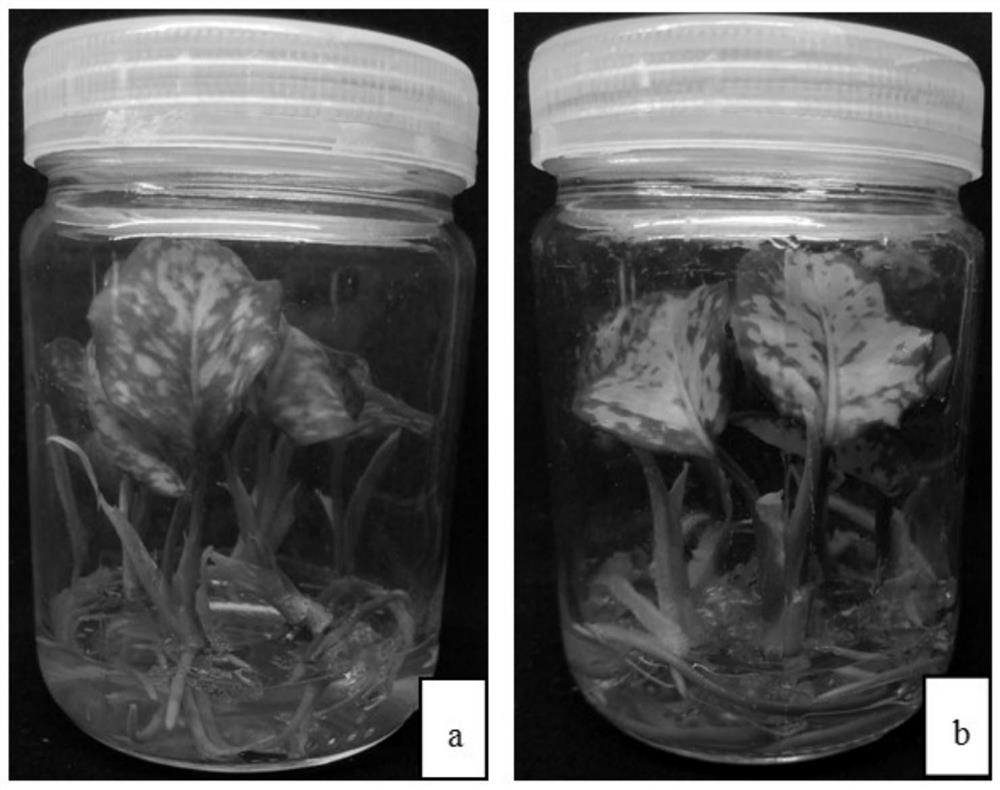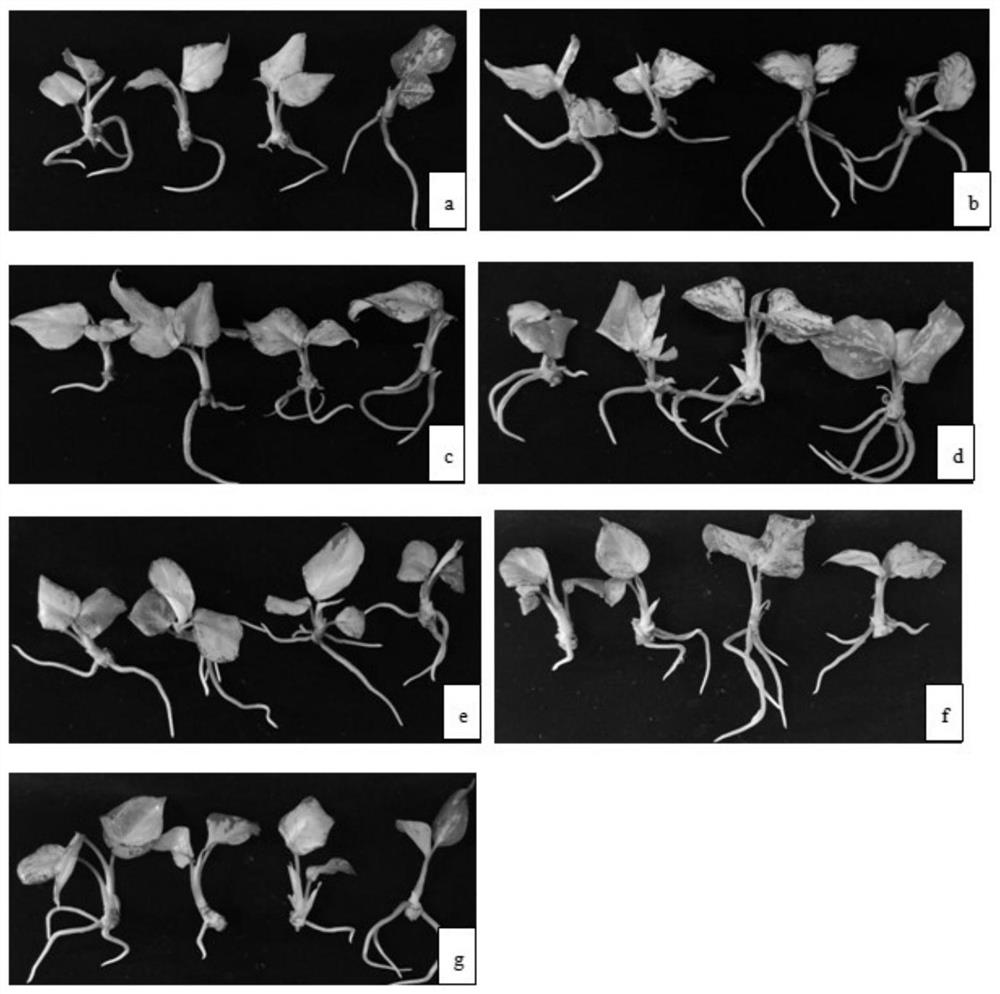Method for changing leaf color of aglaonema rosea tissue culture seedlings by utilizing illumination
A technology for tissue culture seedlings and red leaves, applied in horticultural methods, botanical equipment and methods, applications, etc., can solve the problems of unfavorable production and promotion of red-leafed Grass species, poor red leaf color, and reddish leaf color Turn green and other problems, to achieve the effect of rapid large-scale reproduction and high quality
- Summary
- Abstract
- Description
- Claims
- Application Information
AI Technical Summary
Problems solved by technology
Method used
Image
Examples
Embodiment 1
[0018] Example 1: Light intensity treatment
[0019] 1. Method
[0020] Treatment C1: 3000lx, treatment C2: 4000lx, illumination time 10h / d, temperature (25±1)℃.
[0021] The stem segments of 'Guanghuahong ribica' were used as explants, and the sterilized explants were proliferated by inducing proliferation by cluster buds. , C2 conditions, the light time is 10h / d, the temperature is 25±1℃, the proliferation culture is 50d, 10 bottles / treatment, the number of repetitions is set to 3 times, and the medium formula for the proliferation and differentiation culture is: MS+KT 0.2mg / L+6-BA 3.0mg / L+IBA 0.02mg / L+sucrose 30g / L+agar 5.5g / L, pH=6.0; measure the plant height, leaf length and leaf width of individual seedlings differentiated by proliferation, each treatment Measure 30 strains; continue to cultivate for 40 days, the rooting medium formula is: MS+NAA0.5mg / L+AC 0.2g / L+sucrose 30g / L+agar 5.5g / L, pH=6.0; observe leaf color, count red spots After 120 days, the culling rate o...
Embodiment 2
[0031] Example 2: Light Quality Treatment Test
[0032] 1. Method
[0033] Set seven processes: D1: white light (LED light); D2: red light (100% R); D3: red light: blue light = 7: 3 (70% R: 30% B); D4: red light: blue light = 5:5 (50%R:50%B); D5: red light: blue light = 3:7 (30% R: 70% B); D6: blue light (100% B); D7: purple light; illumination time is 10h / d, the temperature is 25±1℃.
[0034] The stem segments of 'Guanghuahong ribica' were used as explants, and the sterilized explants were proliferated by inducing proliferation by cluster buds. Cultured under the condition of D7, the light time is 10h / d, the temperature is 25±1℃, the proliferation culture is 50d, 10 bottles / treatment, the repetition times are set to 3 times, and the medium formula of the proliferation and differentiation culture is MS+KT 0.2mg / L +6-BA 3.0mg / L+IBA 0.02mg / L+sucrose 30g / L+agar 5.5g / L, pH=6.0; then continue to grow roots for 40 days, the rooting medium formula is: MS+NAA 0.5mg / L+AC 0.2g / L+su...
Embodiment 3
[0046] A method for utilizing light to change the leaf color of a tissue culture seedling of Rhododendron chinensis, comprising the following steps: using the sterilized stem section of 'Guanghua Rhizoma chinensis' as an explant, inducing cluster buds, and the cluster bud induction medium is: : 1 / 2MS+6-BA 2.0mg / L+sucrose 30g / L+agar 6.0g / L, pH=6.0; the clump buds were inoculated in the proliferation medium, the light intensity was 4000lx, the light time was 10h / d, and the temperature was Cultivated under the condition of 25±1°C, the formula of the proliferation medium is: MS+KT 0.2mg / L+6-BA 3.0mg / L+IBA 0.02mg / L+sucrose 30g / L+agar 5.5g / L, pH = 6.0; single plantlets obtained by proliferation and differentiation were placed in rooting medium, and the formula of rooting medium was: MS+NAA 0.5mg / L+AC 0.2g / L+sucrose 30g / L+agar 5.5g / L, pH=6.0: The cultivation was carried out under the conditions of light intensity of 4000lx, light time of 10h / d, and temperature of 25±1℃; the rooted se...
PUM
 Login to View More
Login to View More Abstract
Description
Claims
Application Information
 Login to View More
Login to View More - R&D
- Intellectual Property
- Life Sciences
- Materials
- Tech Scout
- Unparalleled Data Quality
- Higher Quality Content
- 60% Fewer Hallucinations
Browse by: Latest US Patents, China's latest patents, Technical Efficacy Thesaurus, Application Domain, Technology Topic, Popular Technical Reports.
© 2025 PatSnap. All rights reserved.Legal|Privacy policy|Modern Slavery Act Transparency Statement|Sitemap|About US| Contact US: help@patsnap.com



